| Home |
| Rarities Committee |
| IL400 Club |
| Checklist |
| Monthly Summaries |
| Birding Reports |
| Rarity Alerts |
| Historical Records |
| Articles |
| Gallery |
| Video Clips |
| Contact Us |
Oriental Turtle Dove (Streptopelia orientallis), Ashdod area, 27/02/2010
On February 27th, Amir Ben Dov found a 1st year Oriental Turtle Dove on the main road to Ashdod port. Due to the difficulty of identifying this species, its true status in Israel is unclear. As for now, this is only the 5th fully documented record.
Hadoram Shirihai, was kind enough to provide his inputs in regards to this excellent record:
It is about the recent record of the Oriental Turtle Dove Streptopelia orientalis that Amir found and asked my opinion about its identification (in direct email correspondences).
At first glance when I checked the images I thought that this is maybe another example of the ‘tricky’ dark Turtle Dove S. turtur
(of the race S. t. arenicola), which I saw and trapped in Eilat quite a few times in the past.
I never had the time to publish notes about such ‘tricky’ birds, but in general such ‘tricky meena-like Turtle Dove’
are very similar in plumage and general heaviness appearance to that of meena of Oriental Turtle Dove, some such birds are even
impossible to label specifically, and especially with juv/1st-winter birds.
Maybe such tricky dark Turtle Dove could be related to hybrids, but I am not totally convinced.
Nevertheless, I have taken deeper look at Amir’s bird, and I think that it is after all meena (Oriental Turtle Dove).
I can list for you all the important marks that make it as such, but also what is perhaps still disturbing me:
1. Bulkier/heavier impression – good for meena.
2. Primary-projection shorter – better for meena.
3. Poorly developed red skin around the eye is also good for meena of Oriental Turtle Dove.
4. Nape and hindneck pinky-brown toned, contrasting with grey crown – better for meena.
5. Four black neck bars 4, which is good for both species (but could be diagnostically with up to 5-6 bars in meena).
6. The bluish (rather than white) colour of intervening pale bars of the neck is better for meena, but note that especially race arenicola of Turtle can show some blue on the pale neck barring too.
7. Darker mottling development on mantel is better for meena. However, the dark blue-grey on rump and uppertail-coverts is good for both meena and arenicola.
8. Well-defined/narrower deep orange-rufous fringes on scapulars and tertials is better for meena, but unfortunately the same coloration is showing on the upperwing coverts, rather being the latter with contrastingly paler fringes (i.e. with tips of greater and median coverts producing effect of pale double wingbars).
However, we can expect that some meena can have more Turtle-like pattern on these coverts, and with also limited contrast between scapulars and tertials and the upperwing coverts.
9. Chest dull pinkish-brown, contrasting with white rear belly and undertail-coverts, is also better for meena.
10. The grey tips to tail feathers (rather than white as in Turtle Dove) and black bases extend onto outer web of outermost feather (outer web all white on Turtle) is also finally good marks for Oriental Turtle Dove.
I also asked my friend Hannu Jannes (Finland) for his advice, and he responded this morning with clear statement that the bird is meena of Oriental Turtle Dove.
I am regarding Hannu as the authority on identification of Oriental Turtle and Turtle Doves, and his paper (published in Alula some years back) is the ultimate publication on the subject.
Congratulations to Amir for a great find!
| Oriental Turtle Dove (Streptopelia orientallis) | ||
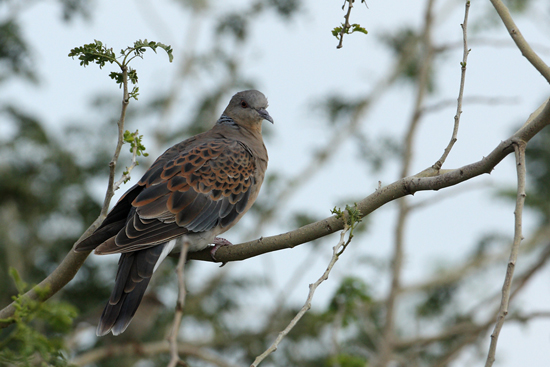 | ||
| Oriental Turtle Dove (Streptopelia orientallis) | ||
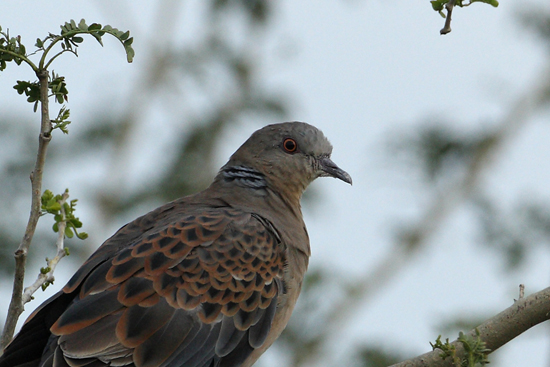 | ||
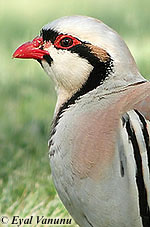 Chukar (Alectoris chukar) Sde Boqer, Apr.04 |
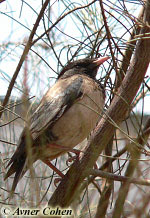 Rose-coloured Starling (Sturnus roseus) Eilat area, May.05 |
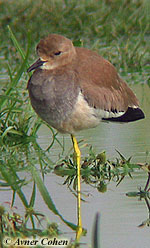 White-tailed Lapwing (Vanellus leucurus) Hefer valley, Oct.05 |
Back to top